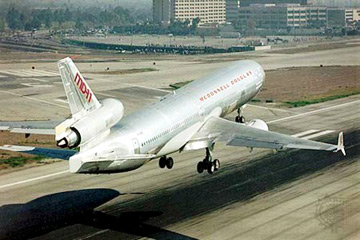Aviation safety
 Flying is one of the safest modes of transport. You actually have a
bigger chance of dying on the road (in a motor accident) than in the air
(in a plane accident). Every day, thousands of planes take off and land
all over the world. Every year, millions of flights operate without any
incident at all. Flights are generally so safe as to be perceived as
mundane affairs. Flying is one of the safest modes of transport. You actually have a
bigger chance of dying on the road (in a motor accident) than in the air
(in a plane accident). Every day, thousands of planes take off and land
all over the world. Every year, millions of flights operate without any
incident at all. Flights are generally so safe as to be perceived as
mundane affairs.
Having said that, emergencies and accidents do happen occasionally.
There are some accidents where no lives are lost - the Miracle on the
Hudson, when a plane successfully made a water landing leading to the
rescue of all on board, is a classic example. On the other hand, there
have been very tragic incidents from time to time where all on board
have perished due to terrorist acts, hijacking, pilot error, bad
weather, mechanical problems, fire or even sheer bad luck.
Whenever a plane accident or crash occurs, our faith in flying is
affected a bit and then we tend to forget all about it in a few weeks at
least until the next one comes along. Most passengers do have an
entirely irrational fear of flying, despite the safety aspects of modern
airliners. However, if you want to travel to the ends of the Earth,
there really is no other alternative - within continents or countries,
other means of transport may be available.
The recent aviation accident - the disappearance of Malaysian
Airlines flight MH 370 - is one of the most baffling mysteries in modern
times. However, this column does not seek to dwell on this mystery and
indeed, some indications of the whereabouts of the missing plane could
hopefully have been found by the time you read this. As I write this,
speculation is rife on the fate of the plane and many theories have been
floated by various experts.
Advances
This column is about the latest advances in aviation and related
technologies (avionics, communications, Internet etc) which could
enhance safety in the air and also make follow-up searches and
investigations easier if an accident, minor or major, occurs. After all,
one of the biggest worries surrounding MH 370 is the lack of data on the
plane’s final movements which has hindered search efforts.
 Planes do have hundreds of safety aids built-in (some with back-ups)
and there is some support from the ground too in the form of ATC (Air
Traffic Control) which is a live voice guidance system that enables the
pilots to know where they are in relation to other planes, nearest
airports and cities and even weather patterns. Most modern airplanes
also have ‘glass cockpits’ where much of the information is displayed on
huge LCD screens in an easy to read way. Many in-flight manuals and
checklists have also been loaded to iPads for easy reference, replacing
bulky paper manuals. Planes do have hundreds of safety aids built-in (some with back-ups)
and there is some support from the ground too in the form of ATC (Air
Traffic Control) which is a live voice guidance system that enables the
pilots to know where they are in relation to other planes, nearest
airports and cities and even weather patterns. Most modern airplanes
also have ‘glass cockpits’ where much of the information is displayed on
huge LCD screens in an easy to read way. Many in-flight manuals and
checklists have also been loaded to iPads for easy reference, replacing
bulky paper manuals.
The most important factor in aviation safety is still the human
element. It is important to assess the mental and physical health of
pilots from time to time (one theory which gained widespread traction
was that the MH 370 pilot could have committed suicide). In the award
winning movie Flight “inspired by true events”, Denzel Washington plays
the role of a pilot who is addicted to alcohol and cocaine and there
have been several similar cases in real life too.
Training is another vital aspect. It is also equally important to
give the pilots refresher training in the simulator and in the air. That
way, they will know how to handle any emergency. Thankfully, most modern
cockpits look similar in spite of having two leading manufacturers
(Boeing and Airbus - the missing plane is a Boeing 777) and different
seating capacities.
There is a theory with regard to MH 370 that the pilots may have
passed out due to lack of oxygen after an onboard electrical fire. If
this is proved to be true, manufacturers should strive to have a
separate, self-contained air supply for the pilots sufficient for one
hour at least, so that they can guide the affected plane to the nearest
airport.
All planes are also equipped with a Flight Data Recorder (otherwise
known as the Black Box, which is actually orange) and a Cockpit Voice
Recorder which records conversations between the pilots and also their
interaction with ATC. At present, both these are physically recorded to
devices in the plane itself. The Black Box can resist fire for several
hours and is not damaged by water. It has a battery which lasts for
around 30 days. The Black Box has to be recovered from the crash site in
the event of a crash.
Streamed
Many analysts have questioned why the data cannot be streamed in
real-time to the ground instead of being physically recorded for review
later. With today’s technology, it should indeed be possible to do so.
At any given moment, thousands of planes are in the sky which means a
huge amount of data to be processed.
However, such technological barriers can be overcome through a joint
collaboration among governments, aircraft manufacturers, airlines and
avionics suite manufacturers, with the blessings of the International
Civil Aviation Authority. Such a system will be very useful in the case
of ‘vanished’ flights such MH 370 where the Black Box may never be
recovered.
Some analysts have also called for the installation of CCTV cameras
linked to ground stations in the passenger cabin and the cockpit. (Many
trains already have this feature, but given the complexity of
downlinking video signals from the air, it may be prohibitively
expensive even if technologically possible).
While reading through the barrage of material on MH 370, I found a
rather interesting article on why no passengers had used their cellular
telephones to alert someone on the ground to a hijack or emergency
situation in the plane if it was flying low. The author theorised that
any hijackers present would have jammed the signals. In-plane cell phone
coverage already exists. More airplanes should install this feature and
also anti-jamming equipment, so that someone can call the ground.
Satellite phones and Wi-Fi should also be made available.
Next week, we will look at more safety aspects of flying. |

